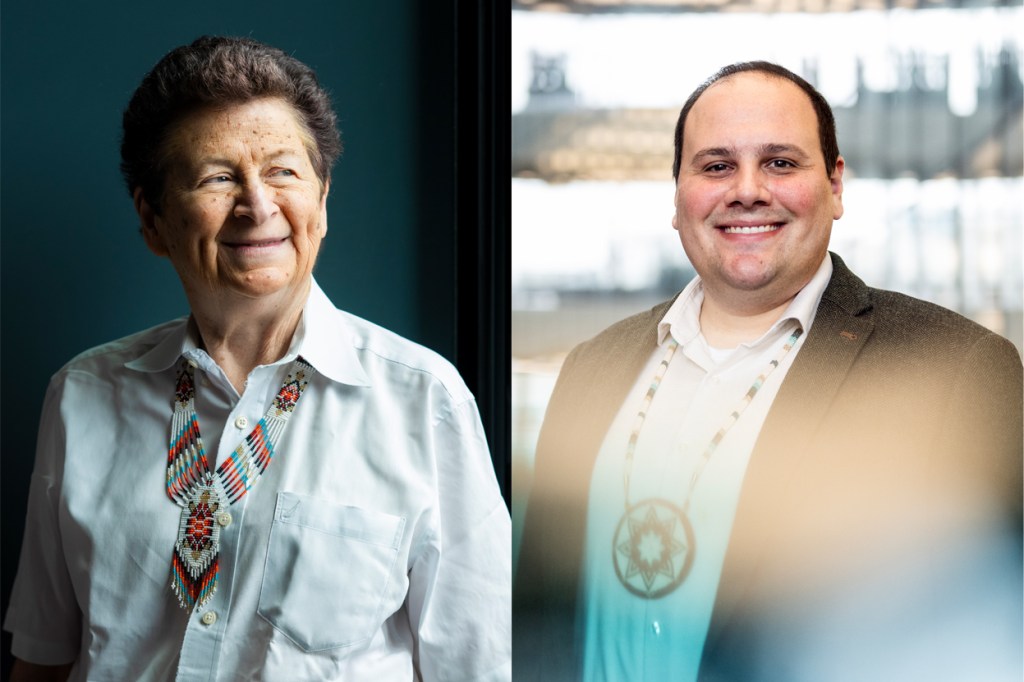Two Northeastern professors receive awards from American Indian Science and Engineering Society
Professor Mary Jo Ondrechen and assistant professor Jesse Peltier have won Professional Awards from the American Indian Science and Engineering Society — which also facilitated their decade-long mentorship.

In 2011, Mary Jo Ondrechen (Mohawk Nation) was elected as chair of the American Indian Science and Engineering Society (AISES) board of directors, and in 2013 she pitched a new project to the National Science Foundation on behalf of AISES: a pathways program to help Native American undergraduate, graduate and postdoctoral students find their way to faculty positions in higher education.
Little did she know that, 10 years later, a member of the program’s first cohort would find his way into the same department at the same institution where she also works.
Jesse Peltier (Turtle Mountain Band of Chippewa and Nakota from White Bear First Nations), an assistant professor at Northeastern University, joined the chemistry and chemical biology department where Ondrechen is a full professor this year. But Ondrechen has been a mentor for far longer than that, Peltier says.
“Pretty much at the beginning of my graduate studies,” Peltier recalls, “I would meet with Mary Jo regularly. She would come to San Diego pretty frequently and we would get lunch, and she would just talk me through a lot of the challenges that I was facing, because, you know, the Ph.D. in many ways is a mental game.”
Now, both Peltier and Ondrechen have received AISES Professional Awards that will be bestowed at the organization’s annual conference in October.
The AISES Professional Awards are granted to five individuals annually, one per category: Ondrechen has received the Technical Excellence Award, and Peltier the Most Promising Engineer or Scientist Award.
As a graduate student, Peltier made several discoveries, including a “copper complex” that emitted blue light, a luminescence more commonly found in “heavy metals like iridium, platinum, palladium,” he says.
Featured Posts
This discovery, in a much more earth-abundant and less expensive metal, has profound repercussions for the manufacture of OLED devices, which rely on luminescent materials.
At Northeastern, Peltier has continued this work on sustainable materials, aiming to design more efficient “energy storage materials” and “metal organic frameworks that are like microscopic sponges,” capable of storing “energy dense small molecules like hydrogen, capturing greenhouse gases and purifying mixtures of feedstock chemicals in an energy-efficient manner.”
Ondrechen, meanwhile, “was applying AI to biochemistry problems before it was fashionable,” she says, using machine learning as far back as 2008 “to extract knowledge about proteins and enzymes.”
Enzymes, Ondrechen says, are “nature’s catalysts,” so the Ondrechen Research Group is “trying to design protein catalysts for industrial reactions to convert the chemical industry to enzyme-catalyzed processes.”
These processes, she continues, would “use less energy and produce fewer unwanted byproducts.”
A computational chemist, she notes that her group also works “on methods to interpret the genome, and we are also the computational support for drug discovery projects.”
Both scholars recognize AISES as an important part of their professional story.
Ondrechen has attended the AISES conference for 30 years. “One of my cousins told me about it,” she says. Attending the conference for the first time, “I was blown away that, you know, the world of science and Indigenous culture came together. It was like a homecoming.”
When she helped found the AISES program Lighting the Pathway to Faculty Careers for Natives in STEM, it was out of a desire to give back.
“The goal of AISES is to substantially increase the number of Indigenous people in the STEM fields,” Ondrechen says. “For a long time I thought, ‘It’s gonna be hard to achieve that goal when there’s so few Natives on the faculty, we really need to build up.’”
“Even tribal colleges,” she notes, “if they have STEM courses at all, they’re typically taught by non-Natives.”
The Lighting the Pathway program would “assist Native students who aspire to become faculty members, helping students build up their resumes, helping undergrads get summer research experience, apply for fellowships,” Ondrechen says, with additional help for graduate students and postdocs.
“There are now 28 Pathways scholars in faculty jobs across the country,” she continues.
One of those scholars is Peltier. Through the Lighting the Pathway program, where he first met Ondrechen, he received advice about how to write winning applications.
“I attribute a good portion of my success to having that mentorship relationship,” Peltier says. “That was so foundational.”
Then an opportunity in Ondrechen’s own department appeared.
“We had a faculty opening last year, and Jesse was one of the applicants,” Ondrechen recalls. “I was his mentor in the Pathways project — so he’s like a son to me, so I’m biased.
“But everyone else thought that Jesse was fantastic. So Jesse was offered the job, and we got him.”
“If I’m going to be completely candid, there were moments early on during my Ph.D. where I wondered if I had what it takes to continue in Academia,” Peltier says.
“Having Mary Jo there was … to have somebody to keep pushing you along your goals, even if they’re lofty, and then to have it come full circle to where I’m now at Northeastern, is just very powerful to me.”
“Now it’s time for that reciprocity,” Peltier concludes, who started his own AISES chapter at his undergraduate institution.
“Along the way, I’ve always tried to set up programs to help Native students, but now I’m actually a faculty member, and so I can have a stronger position, a stronger role as a mentor.”











